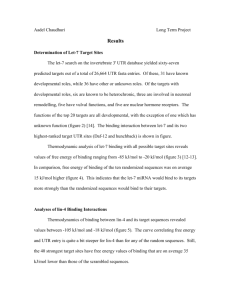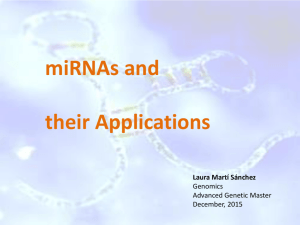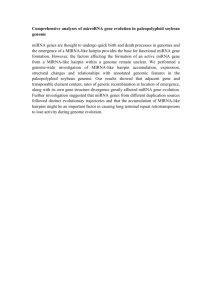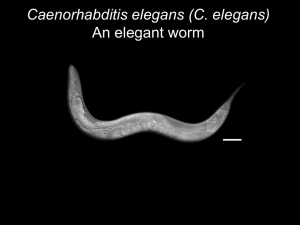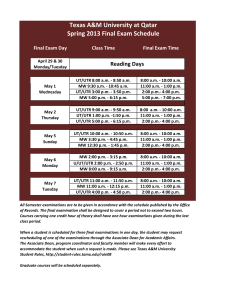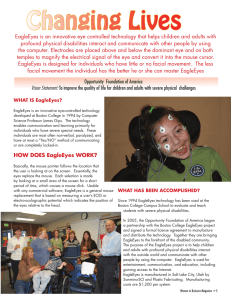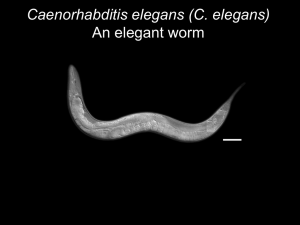SEP 13 211 GD LMM
advertisement
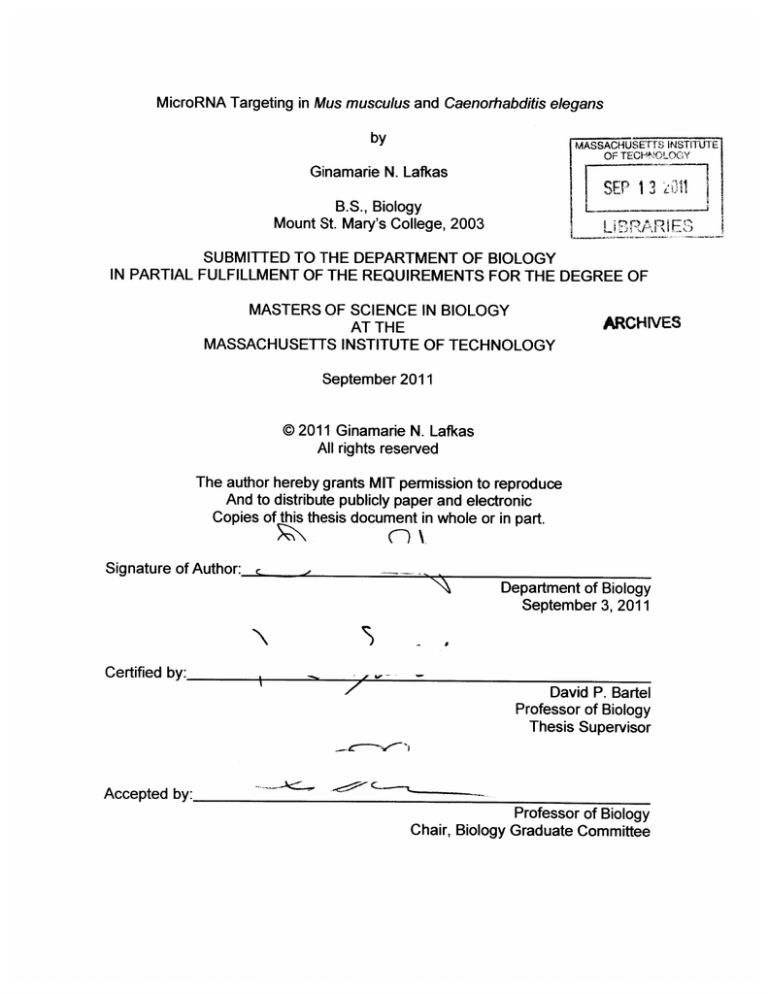
MicroRNA Targeting in Mus musculus and Caenorhabditis elegans by MASSACHUSETTS INSTITUTE OF TECHNOLOGY Ginamarie N. Lafkas SEP 13 211 B.S., Biology Mount St. Mary's College, 2003 R rI ,,S GD LMM SUBMITTED TO THE DEPARTMENT OF BIOLOGY IN PARTIAL FULFILLMENT OF THE REQUIREMENTS FOR THE DEGREE OF MASTERS OF SCIENCE IN BIOLOGY AT THE MASSACHUSETTS INSTITUTE OF TECHNOLOGY ARCHIVES September 2011 @2011 Ginamarie N. Lafkas All rights reserved The author hereby grants MIT permission to reproduce And to distribute publicly paper and electronic Copies of this thesis document in whole or in part. Signature of Author: Department of Biology September 3, 2011 - Certified by: 7David P. Bartel Professor of Biology Thesis Supervisor Accepted by: Professor of Biology Chair, Biology Graduate Committee MicroRNA Targeting in Mus musculus and Caenorhabditis elegans by Ginamarie N. Lafkas Submitted to the Department of Biology In Partial Fulfillment of the Requirements for the Degree of Masters of Science in Biology ABSTRACT MicroRNAs (miRNAs) are small, approximately 22 nucleotide RNAs that regulate gene expression post-transcriptionally by base-pairing to complementary sites in the target mRNA. The first miRNA, lin-4, was discovered in 1993 in Caenorhabditis elegans; since then hundreds of miRNAs have been identified in C. elegans, Drosophila melanogaster, plants, mouse, and humans, where they approach a number equivalent to 1-2% of the protein-coding genes. With the exception of plants, miRNAs most commonly regulate targets by imperfectly pairing to 3' untranslated regions (UTRs), leading to translational repression or mRNA destabilization. The microRNA miR-196 is encoded at three paralogous locations in the HoxA, B, and C clusters in mammals and has conserved complementarity to the 3'UTRs of Hoxb8, Hoxc8, and Hoxa7; in particular, miR-1 96 has complete complementarity to Hoxb8 with the exception of a single G:U wobble. In 2004, Yekta et al., were able to detect RNA fragments diagnostic of miR-1 96-directed cleavage of Hoxb8 transcript in mouse embryos, and cell culture experiments showed down-regulation of Hoxb8, Hoxc8, Hoxd8, and Hoxa7. To address the biological significance of miR-196 mediated repression of Hox genes in vivo, we attempted to generate targeted transgenic mice for the Hoxa7, b8 and c8 genes. These mice would allow us to study the resulting phenotypic and molecular consequences and determine the impact this regulation has on establishment of the anterior-posterior axis in the developing embryo as well as its role in defining the expression boundaries of the individual Hox genes in vivo. The lin-4 miRNA plays a role in regulating the heterochronic genes involved in larval development in C. elegans. We used luciferase assays to test the efficacy of the seven proposed lin-4 binding sites in the lin-14 3'UTR and to determine if lin-4 iscapable of recognizing and mediating repression through them. The wild-type lin-14 3'UTR was compared with mutant UTRs in which the lin-4 target sites were mutated. We determined that the three canonical 8mer sites are functional, as expected, and that at least one of the four additional sites is also recognized by lin-4 and contributes to the overall repression of the lin-14 3'UTR. David P. Bartel Professor of Biology Thesis Advisor Acknowledgements First I would like to thank my advisor Dave and the entire Bartel lab for making my graduate experience so fulfilling. I feel very lucky to have been able to spend everyday in lab learning from and laughing with some of the most gifted and giving scientists I have ever come across. I would especially like to thank Calvin Jan, Andrew Grimson and Sue-Jean Hong for their thoughtful discussions about science and their support during some of the more difficult times in graduate school, knowing I was not alone was more valuable than words could ever express. A special thanks to Laura Resteghini, I'm convinced the Bartel lab would cease to exist if she was not around. Making the lives of 20+ scientists run smoothly (at least while in lab) is not a trivial task and she made it seem effortless... a true rock star! My time in graduate school would have been monumentally incomplete if not for Olivia Rissland. I will miss our morning caffeine induced laugh sessions and all the moments where words were not even necessary. Thank you for constantly sharing your amazing scientific brain with any and everyone, for your passion for what you do, it is truly infectious, for your constant support and most of all for your friendship-one of the greatest gifts I've been given thus far. To all of my friends who made life outside of lab fun, there are to many of you to name but I owe most of my sanity to you all, so thank you. Many, many thanks to my family for their unwavering love and support throughout my life, I would not be who I am today without you. To my sisters Jen and Dani, distance will never diminish the bonds we share-you are the best friends a girl could ever ask for, thanks for standing by me through the best and worst times, I love you both so much! Most importantly I thank my fiancee Nate, you are the single best thing to come out of my time at MIT. Thank you for believing in me even when I was unable, for your unconditional love, your patience and for filling the last four years of my life with more love, laughter, and honest happiness than I could have ever hoped for--I love you so much. 4 Table of Contents Abstract 2 Acknowledgements 3 Table of Contents 4 Chapter 1 6 The role of miR-196 in regulating the Hox cluster Chapter II 30 Regulation of lin-14 by the /in-4 microRNA References 45 The role of miR-1 96 in regulating the Hox cluster Abstract To further characterize the role of miR-1 96 in regulating the expression of Hoxb8, Hoxc8, and Hoxa7, we attempted to generate targeted transgenic mice with mutant miR-196 sites that would prevent miRNA-mediated regulation of these targets. Targeting vectors were constructed using recombineering for each of these three genes. To disrupt target recognition by miR-196, nucleotides that complement the 3 rd, 5 th, and 7 th nucleotides inthe seed of miR-196 were mutated in the 3'UTR's of each Hox gene construct. All three constructs were verified by sequencing and diagnostic restriction digests, then linearized and submitted to the Rippel Mouse ES Cell & Transgenics Facility. Genomic DNA from embryonic stem cells that survived selection were screened by Southern Blot to check for homologous recombination and single integration at each of the three Hox genes. Abbreviations miRNA, microRNA; UTR, untranslated region; ES cells, embryonic stem cells; nt, nucleotide, kb, kilobases; neo, neomycin Introduction The regulation of gene expression is critical for the viability of all living systems. There are many stages at which the expression of a gene can be modulated, including modifications of the DNA, control of transcription and translation, changes in mRNA processing or stability, and post-translational modifications. It is the ability to control the timing, level, and location of gene expression that allows for cellular differentiation (how cells become specialized), morphogenesis and adaptability of an organism over time. When any of these factors is disrupted, as in the case of transgenic mice that are either null for or overexpress a given Hox gene, embryos can exhibit gross morphological defects ranging from homeotic transformations in vertebrae to craniofacial abnormalities (Krumlauf, 1994). For example, mice homozygous for a loss-of-function Hoxb8 allele, a member of the Hox family of transcription factors important for axis formation in embryos, suffer from defects in rib formation, degeneration of spinal ganglia and excessive grooming behaviors after birth (Greer and Capecchi, 2002; van den Akker et al., 1999). In addition, ectopic expression of Hoxb8 can lead to complete forelimb duplications, persistence of the first spinal ganglion, posterior transformations of lower cervical vertebrae and embryonic lethality in a homozygous state (Fanarraga et al., 1997). Therefore, determining all the mechanisms by which developmental genes are regulated is not only valuable for a clear understanding how development proceeds in its wild-type state but also for accurately assessing what leads to diseased states. The Hox clusters provide a good model for studying the intricacy of developmental gene regulation. Animal microRNAs are -22 nt non-coding RNAs that regulate gene expression post-transcriptionally through base-pairing to their target mRNA (Lai, 2003). The first miRNA, lin-4, discovered in C.elegans plays a role in regulating the heterochronic genes involved in larval development (Lee et al., 1993); since then, through deep sequencing, computational and genetic methods, hundreds of miRNAs have been identified in plants and animals, where they play roles in regulating genes involved in processes from developmental patterning, to signaling pathways and even cancer (Lagos-Quintana et al., 2003; Lee and Ambros, 2001; Lewis et al., 2003; Lim et al., 2003; Stark et al., 2005). miRNAs are derived from polymerase Il transcripts known as the primary miRNAs (primiRNAs) (Lee et al., 2004). The mature miRNA, capable of silencing targets, is generated by two key processing steps: 1) cleavage by Drosha, a nuclear Ribonuclease Ill (RNase Ill), to produce the precursor miRNA (pre-miRNA), which is exported out of the nucleus and 2) cleavage by Dicer, a cytoplasmic RNase 111, to produce a -22 nt miRNA duplex (Bohnsack et al., 2004; Grishok et al., 2001; Hutvagner et al., 2001; Ketting et al., 2001; Lee et al., 2003; Lund et al., 2004; Yi et al., 2003). One strand of the miRNA is loaded into a ribonucleoprotein complex known as the RNA-induced silencing complex (RISC) and the other, known as the star strand, is degraded (Khvorova et al., 2003; Schwarz et al., 2003). miRNAs recognize and repress messages by basepairing to targets with complementarity primarily to the 5' region of the miRNA known as the seed (nucleotides 2-7) (Lewis et al., 2003). There are four types of target sites that contribute to miRNA-mediated repression, an 8mer, a 7mer-m8, a 7mer-A1 and a 6mer, with the 8mer typically yielding the most robust repression (Figure 1) (Bartel, 2009; Grimson et al., 2007). Most targets in metazoans are repressed through some mechanism of translational inhibition or mRNA destabilization, but when there is extensive complementarity the miRNA can cause cleavage of the target (Bartel, 2004; Guo et al., 2010; Liu et al., 2005; Maroney et al., 2006; Nottrott et al., 2006; Olsen and Ambros, 1999; Petersen et al., 2006; Pillai et al., 2005; Thermann and Hentze, 2007). In 2004, Yekta et al., reported that Hoxb8 has one site in its 3'UTR with near perfect complementarity to miR-196 and went on to demonstrate that, in mouse, miR-196 directs cleavage of Hoxb8 (Yekta et al., 2004). This is one of the rare targets in mammals known to be cleaved by a miRNA (Shin et al., 2010). The three miR-196 genes, miR-196a-1, miR-196a-2, and miR-196b, all map to locations in three of the four Hox clusters, HoxA, HoxB, and HoxC respectively, with the relative position of each gene being evolutionarily conserved in vertebrates (Lagos-Quintana et al., 2003; Lim et al., 2003). The miR-1 96 miRNAs have target sites in many of the Hox genes that are positioned more anteriorly to the miR-196 loci (Figure 2) (Yekta et al., 2008). Cleavage of Hoxb8 by miR-196 is detectable in mouse embryos and luciferase reporter assays and cell culture assays for Hoxa7, Hoxc8, and Hoxd8 demonstrated that a metazoan miRNA is capable of mediating posttranscriptional repression of target mRNAs. Sensor transgene studies conducted in mice indicate that miR- 196 is present in the posterior trunk (Figure 3) (Mansfield et al., 2004). Interestingly, the anterior end of miR-196 expression in these mice is similar to the posterior boundary of Hoxb8 expression, suggesting that miR-1 96 may act to prevent Hoxb8 expression in this posterior region. Limb specific conditional Dicer knockouts mice showed that ectopic Retinoic Acid (RA) expression, which normally induces Hoxb8 expression only in the anterior forelimb, could induce expression of Hoxb8 mRNA in the hindlimb. However, this induction was not possible in wild-type mice. Additionally, misexpression of miR-196 in chick embryos not only reduces Hoxb8 expression throughout the embryo but prevents RA soaked beads implanted into the forelimb from inducing Hoxb8 expression (Hornstein et al., 2005). While it is known that miR-196 is expressed in the developing embryo, directs cleavage of Hoxb8 mRNA in the hindlimb, and is capable of repressing translation of other Hox genes in reporter assays, the developmental importance of this regulation is not known. In the last 5 years, the global impact of miRNA-mediated repression has been addressed in part by the generation of various miRNA knockout mice. The mice from these different studies display phenotypes with varying levels of severity. The miR-155 knockouts have compromised immune systems that result in defects in adaptive immunity and autoimmunity, loss of miR-1-2 can result in lethal heart defects, and miR-208 knockout mice suffer from heart defects when subjected to cardiac stress (Rodriguez et al., 2007; Thai et al., 2007; van Rooij et al., 2007; Zhao et al., 2007). While all of these knockouts provide insight into the role of miRNA-mediated regulation, the identification of the miRNA target genes responsible for the defects has been a difficult task, as one miRNA can regulate many targets. Generating transgenic mice, in which one gene target of a miRNA is mutated to avoid regulation, provides a system for analyzing the individual relationship between a miRNA and its target. The Hox clusters are ideal for this experiment because a single cluster contains multiple genes regulated by miR-196, potentially though different mechanisms. By mutating the miR-196 binding sites in the 3'UTR of a particular Hox gene, and not the miRNA itself, we can assess the role of miR-1 96 as a regulator of the Hox clusters by characterizing the phenotypic and molecular consequences that result when this mechanism of regulation is lost. We attempted to generate targeted transgenic mice in order to address the role that miR-196 plays in regulating specific genes in the Hox cluster and the impact this regulation has on establishment of the AP axis in the embryo as well as its role in defining the expression boundaries of the individual Hox genes in vivo. Materials and Methods Generating Targeting Constructs for Hox genes Three targeting vectors, one for each of the Hox genes mentioned previously, were made using recombineering established by Liu et al., (Liu et al., 2003). The 3'UTRs were first cloned into a pBluescript vector for mutagenesis before recombination into the final targeting vector. There are five miR-196 sites in the Hoxa7 3'UTR, one site in Hoxb8, and six sites in Hoxc8 (Figure 4). In each construct, all miR-196 seed sites in the 3' UTRs were mutated using the Stratagene QuikChange Multi Site-Directed Mutagenesis kit using mutant primers (IDT). To disrupt target recognition by miR-196, nucleotides that complement the 3 rd, 5 th, and 7 th nucleotides in the seed of miR-196 were mutated in the 3'UTR's of each Hox gene changing the seed site from 5ACUACCUA 3 to 5AGUCCGUA 3' (an 8mer site as an example). In all three constructs, the introduced mutations either created or removed a restriction enzyme recognition sequence that could be used for allelic identification in later assays. Once the 3' UTR's had all miR-196 binding sites mutated, they were recombined into targeting vectors containing a Diphtheria Toxin (DTA) driven by the phoshoglycerate kinase (PGK) promoter for negative selection in embryonic stem (ES) cells. After the initial recombination was confirmed by sequencing, a PGKneomycin transferase (neo) cassette was recombined into the vectors downstream of the 3'UTR mutations for positive selection (Figure 5). After each step in the cloning process, the vectors were checked by restriction digest, polymerase chain reaction (PCR), and sequencing to ensure accurate construction. Targeting and Screening of Hox Targeting Constructs Completed constructs were linearized and electroporated into C57BL/6 ES cells. Several hundreds of neo resistant ES cell clones were selected for each Hox gene. Screening for positive clones was first carried out by Southern blot analysis with a probe sequence outside of the long arm and the neo probe, to identify correct homologous recombinants and to exclude clones with multiple integrations, respectively. The same ES cell clones were also screened by PCR with a primer residing outside of the short arm and a primer within the neo cassette. Preparing ES Cell DNA and Probes for Southern Screening Genomic DNA from Hoxa7, c8, and b8 clones were digested overnight, the digests were loaded into a 0.7% agarose gel, run overnight at 40C and the DNA was transferred from the gel to a Nytran SuPerCharge membrane overnight using the Whatman TurboBlotter Alkaline Transfer System (Whatman). The long arm probes for each targeting construct were generated using PCR on genomic mouse DNA, gel purified and radiolabeled with [a- 32P]dCTP using the Rediprime 11DNA Labeling System (Amersham). The labeled probes were purified from unincorporated label using illustra MicroSpin G-50 columns (GE Healthcare). Southern Blot Analysis Following transfer, the DNA was fixed to the membranes by UV crosslinking at 254 nm for one minute using a Stratalinker (Stratagene Cloning Systems, La Jolla, California, USA). The membranes were pre-hybridized in 30 ml of Quick Hyb solution (Stratagene) for one hour at 600 C. Purified probe and salmon sperm DNA were boiled for 5 min and added directly to the hybridization buffer. The membranes were hybridized with probes rotating overnight at 600 C. Following hybridization the membranes were washed and exposed overnight at room temperature. Results and Discussion In HeLa cell reporter assays, miR-196 is capable of down regulating Hoxa7, Hoxb8, Hoxc8 and Hoxd8. Hoxb8 has a near perfect complementarity to miR-196 with the exception of a single G:U wobble and miR-196-directed cleavage of Hoxb8 has been detected in total RNA from day 15 to 17 mouse embryos (Yekta et al., 2004). Although it is clear that miR-196 is capable of and does regulate members of the Hox gene family, the biological significance of this regulation remains unknown. To address the regulatory significance of miR-196, we attempted to generate targeted transgenic mice for three of the Hox family members, Hoxa7, b8 and c8 to study the molecular and phenotypic consequences that loss of miRNA regulation has on the developing mouse embryo. All three of the targeting constructs for the Hoxa7, b8 and c8 genes were submitted to the Rippel Mouse ES Cell & Transgenics Facility at MIT to generate targeted transgenic mice. If properly targeted these mice would possess one allele for the previously mentioned genes with a 3'UTR containing mutant miR- 196 binding sites thus preventing miR-196 mediated repression of that allele in the developing mouse embryo. The first round of targeting yielded 503 clones for Hoxa7, 354 for Hoxb8 and 476 for Hoxc8 for screening via Southern Blot. A positive clone from screening Hoxa7 clones with a long arm probe would yield 2 bands: the wild-type band at 11.5 kilobases (kb) and a band at 9.5 kb representing the mutant recombinant band (Figure 6). A positive clone from a Hoxb8 screening with a probe recognizing the long arm would yield a wild-type band at 12.1 kb and a band at 9.7 kb representing the mutant recombinant band (Figure 7). A positive clone from screening Hoxc8 with the long arm probe would yield an 11.1 kb wild-type band and a 9.3 kb mutant recombinant band (Figure 8). The first round of southern screening yielded no positive recombinants for any of the three targeted loci. The constructs were resubmitted three more times, twice to the Rippel Mouse ES Cell & Transgenics Facility and once to Harvard Medical School's Brigham & Women's Hospital Transgenic Core Facility. In addition to resubmitting the constructs, the electroporations were switched from using C57BL/6 ES cells to V6.5 ES cells, a 129/B6 F1 hybrid line whose cells are supposed to be highly robust. A total of 6574 clones were screened across all three constructs with no positive recombinants. Although targeting did not work for the three Hox genes attempted here, there are a few known parameters that could be changed in an attempt to increase the chances of homologous recombination in the ES cell and subsequent survival of that cell through the selection process. The goal in generating a construct for targeted transgenics is to minimize disruption of gene function especially to the surrounding genes. The frequency of homologous recombination depends on the degree of sequence match and the length of the matching sequence (Hasty et al., 1991; te Riele et al., 1992). Some studies suggest that a minimum of 7 kb of perfectly matched DNA sequence should be present for homologous recombination to occur at a practical frequency. For the targeting constructs in this study, there was approximately 3.5 kb of perfect sequence match before the first UTR mutation. Perhaps if the amount of perfect homology of the long arm (where the UTR mutations were placed) was increased upstream of the mutations, targeting efficiency would also increase. A second possible factor affecting targeting is the presence of the neo cassette. To prevent long term disruption of gene expression in the targeted region, loxP sites flank the neo gene to allow for excision of the cassette by expression of Cre recombinase; however, the PGK-neo cassette can have unintended consequences on the expression of the targeted and adjacent genes (Meyers et al., 1998; Nagy et al., 1998; Olson et al., 1996). For example, the presence of the neo cassette in the targeted Hoxa2 locus led to knockdown and premature expression in a number of the Hox genes surrounding the neo cassette resulting in death of mice before 3 weeks of age (Ren et al., 2002). Although these effects were not seen until after birth for the Hoxa2 mice, it is possible that the presence or placement of the neo cassette had a negative effect on the ES cell due to targeting of the three loci described here. Acknowledgements We thank Aurora Burds Connor and the Rippel Mouse ES Cell & Transgenic s facility for helpful discussion and advice during the design of the targeting constructs as well as screening ES cells. Figure Legends Figure 1. Types of miRNA target sites. The four types of target sites present in a mRNA that contribute to miRNA-mediated repression: A 6mer complements nucleotides 2-6 in the miRNA seed, a 7mer-m8 has perfect complementarity to nucleotides 2-8 in the miRNA, the 7mer-A1 complements the miRNA seed and has an A at position 1,and an 8mer complements nucleotides 2-8 in the miRNA and has A opposite position 1 of the miRNA. Figure 2. Genomic organization of the mammalian Hox clusters. The four chromosomes encoding the mammalian Hox clusters. The different colored arrows indicate paralogous genes from one of the 13 groups. The direction of arrowheads indicates direction of transcription, small blue and green arrowheads show the location of the miRNAs embedded in the clusters. Dashed red lines are repression based on bioinformatics and cell culture assays. Solid red lines indicate miRNA-mediated repression confirmed in vivo, by cell culture assay and bioinformatics. Figure 3. MiR-196 expression pattern mimics Hox expression in the developing mouse embryo. Sensor transgene study and in situ hybridization for Hoxb8 in the developing mouse embryo. (d)IacZ expression from a sensor transgene containing miR-196 binding sites. lacZ expression is downregulated in the posterior trunk and tailbud. (e)Expression of Hoxb8 detected by in situ hybridization. Hoxb8 is downregulated in the region where miR-196 is expressed. Figure 4. miR-1 96 target site mutations. The 3'UTRs of the 3 Hox genes mutated to prevent miR-1 96-mediated repression. Hoxb8 has one site with almost complete complementarity, Hoxc8 has six miR-196 sites, including a site of extended complementarity and Hoxa7 has five. The red nucleotides indicate the positions in the Hox 3'UTRs that were mutated in the targeting constructs. Figure 5. The final targeting constructs for the three Hox genes in this study. All three vectors contain a PGK-DTA marker for negative selection located downstream of the short arm and a PGK-neo cassette for positive selection located between the short and long arms. The 3'UTR mutations are located in the long arm for all three constructs. Figure 6. Screening for Hoxa7 recombinants. Southern blot analysis on genomic DNA from a series of ES cells that survived electroporation of Hoxa7 targeting construct and selection. The first lane was loaded with a digested BAC DNA as a positive control, followed by a 1kb+ ladder and experimental samples. The red arrows indicate where the wild-type band and recombinant band should appear on the membrane and their expected sizes. Figure 7. Screening for Hoxb8 recombinants. Southern blot analysis on genomic DNA from a series of ES cells that survived electroporation of Hoxb8 targeting construct and selection. The first lane was loaded with a 1kb+ ladder, followed by the experimental samples. The red arrows indicate where the wild-type band and recombinant band should appear on the membrane and their expected sizes. Figure 8. Screening for Hoxc8 recombinants. Southern blot analysis on genomic DNA from a series of ES cells that survived electroporation of Hoxc8 targeting construct and selection. The first lane was loaded with a digested BAC DNA as a positive control, followed by a 1kb+ ladder and the experimental samples. The red arrows indicate where the wild-type band and recombinant band should appear on the membrane and their expected sizes. Figure 1 Canonical sites Atypical sites Bartel, D.P. 2009 ........... Figure 2 1 2 3 4 5 I I II HoxA A- HoxB A 6 A- 4- Am 8 11 Imir-0o A- 7 9 10 I mir-196b . 11 12 A- 13 A- mir-196a-1 mir-196a-2 HoxC ___ I- A ___ A I------------------------- mir-10b HoxD Am Am It Am ji A A A --Tm" Direction of Transcription Yekta, S., et al., 2008 ....... ........ -... .. ........ ....... ... Figure 3 Posterior expression boundary of miR-196 sensor transgene Posterior expression boundary of hoxb8 mRNA Mansfield, J.H., et al., 2004 .......... 7....................... .......... .. ....... ........ ... .......... Figure 4 Target Site Mutations b8 site Hoxb8 5' 3' 31I1111 I111 11 111 53 5 'CCAACC-UGCGAGUCCGUA 3GG=GUGUUUUUU 3 Hoxc8 9 icc-t cG&c 3GGUGOGAs'?QGA i HOXOa - - -iiii- -iiiiiiiii - - - - ll i i c8 site ~ AGUCCGU3 8mer site = E Extended Complementarity = Some Extended Complementarity l = 8mer =7mer-m8 = 7mer-Al UGADGGAD Hox ORF 31 1 1 1 5' 7mer-m8 site UGAUGGAU 5' = = 3' 5GUCCGUA 7mer-A1 site UGADGGAD ----. ......... - - --------- .... . ... ....... .... .......... .. ...... ...... ...... ...... .. Figure 5 PGK-DTA Targeting 160i8 bp HoxB8 5' UTR C8 exoni1 8 Exon2 V3§I196 7mer- HoxC8 B8 ORF Neo 196 7mer-1A 1968mer 1968mer pA Signal PGK-DTA- polyA 1967mer-m8 A 7 Exon Intron HoxA7 A7 Exon2 1st polyA 1968mer 1968mer ::.... ...... :................ Figure 6 BAC Ladder ~y WT1-.,,, 7- Mut - Expected Band Size: Wild-type = 11.5 kb Expected Band Size: Wild-type = 11.5 kb Mutant = 9.6 kb 27 . ..... ........................ ........ ... .......... . ..... . ...... Figure 7 Ladder Mut Expected Band Size: Wild-type = 12.1 kb Mutant = 9.7 kb ... . .. .......... .. .. .... ......... .... . ....... ..... ...... ......... ... ........ . Figure 8 BAC Ladder WT Mut Expected Band Size: Wild-type = 11.1 kb Mutant = 9.3 kb ........... ......... . .. .......... .. ................... ....... .. ... ......... -- - Regulation of lin-14 by the Iin-4 microRNA Abstract The first example of a microRNA regulating a target mRNA was found in C. elegans. The 3'UTR of lin-14 mRNA contains seven conserved sites originally proposed to be recognized by the lin-4 RNA. Three of these sites are now recognized as canonical 8mer sites, while three of the remaining four are offset 6mer sites, which typically mediate only marginal repression. We sought to determine if the lin-4 miRNA is capable of recognizing all seven sites and mediating repression of lin-14 mRNA through them. We used luciferase reporter assays containing the lin-14 3'UTR to compare the wild-type UTR with various forms of a UTR in which the lin-4 seed sites were mutated. We determined that at least one of the three 8mer sites is functional, as expected, and at least one of the four additional sites is also recognized by lin-4 and contributes to the overall repression of the lin-14 3'UTR. Abbreviations miRNA, microRNA; UTR, untranslated region; nt, nucleotide; bp, basepair; Introduction The lin-4 and let-7 genes, the first two miRNAs discovered, were identified in genetic studies by mapping mutant Caenorhabditis elegans loci. Both genes encode small RNAs ~22nt long that derive from a hairpin precursor (Lee et al., 1993; Reinhart et al., 2000; Wightman et al., 1993). Mutant lin-4 nematodes exhibit numerous post-embryonic cell-lineage reiterations with diverse phenotypic consequences, including malformation of the vulva, altered body shape, and extra larval molts (Chalfie et al., 1981; Horvitz and Sulston, 1980). let-7 controls the L4-to-adult transition in C. elegans development and is expressed at the late L3 and early L4 stages in the hypodermal seam cells (Johnson et al., 2003). In let-7 mutants, nematodes fail to execute the L4-to-adult transition, reiterating larval fates and die from bursting of the vulva (Reinhart et al., 2000). Through the methods of molecular cloning and sequencing of cDNAs generated from small RNA gene products in C. elegans, Drosophila and human cells the number of miRNA genes increased dramatically (Lagos-Quintana et al., 2001; Lau et al., 2001; Lee and Ambros, 2001). All of these genes express small RNAs that were derived from larger hairpin precursors. Continued sequencing efforts have expanded the miRNA gene number in nematodes, flies and vertebrates, and also identified large numbers of miRNA genes in planarians and plants (Landgraf et al., 2007; Mourelatos et al., 2002; Palakodeti et al., 2006; Reinhart and Bartel, 2002; Ruby et al., 2006). lin-14 is a heterochronic gene required for specifying the division timings of a specific group of cells during postembryonic development; this specification relies on a temporal gradient of Lin-14 protein expression in the developing worm (Ruvkun and Giusto, 1989). /in-14 gain-of-function (gf) mutants cause reiterations of early cell fates at later stages-specify stages; it was subsequently found that the gf mutations resulted from deletions in the 3'UTR of lin-14, suggesting that the 3'UTR was responsible for the temporal regulation (Wightman et al., 1991). It was noted that /in-4 loss-of-function(lf) mutants phenocopy lin-14(gf) mutants and result in the presence of Lin-14 protein at stages later than L1, indicating that lin-4 is a negative regulator of lin-14 (Arasu et al., 1991; Chalfie et al., 1981; Lee et al., 1993). In 1991, it was determined that the lin-14 3'UTR alone was able to impart the temporal regulation on another unrelated gene, and this regulation was lost in lin-4(lf) mutant background (Wightman et al., 1993). The region responsible for regulation was mapped to an 802 bp region in the 3'UTR of lin-14 that contains seven sites that are complementary to lin-4 (Figure 1). Although the initial papers included two additional 5' nucleotides that we now know are not present in the mature lin-4 miRNA (Lau et al., 2001), three of the seven conserved regions are considered to be canonical 8mer sites for lin-4 (Grimson et al., 2007). Three additional sites belong to a new miRNA site type discovered by Friedman et al. (2009). It is referred to as the offset 6mer (Figure 2) and matches nucleotides 3-8 of the miRNA (Friedman et al., 2009). A single offset 6mer site can contribute to miRNA-meditated mRNA destabilization similar to that seen for a canonical 6mer (Friedman et al., 2009). The last site (site 6 in Figure 1) is referred to as a mismatched site and is not capable of forming a canonical miRNA interaction with the lin-4 miRNA. Despite all that is known now about miRNA targeting in worms, the sites for lin-4 in the lin-14 3'UTR have never been tested for functionality. The aim of this study is to begin to establish how many of the seven originally proposed lin-4 binding sites are capable of contributing to miRNA-mediated repression through the lin-4 miRNA. Materials and Methods Generating lin-14 luciferase constructs The lin-14 3'UTR was PCR amplified from C. elegans genomic DNA and cloned into pBluscript vector for mutagenesis. In each construct all lin-4 seed sites in the 3'UTRs were mutated using the Stratagene QuikChange Multi SiteDirected Mutagenesis kit with mutant primers (IDT). All mutagenesis was verified by sequencing before transferring to the expression vector. The fully mutagenized UTRs were PCR amplified and subcloned into the plS1 renilla luciferase reporter vector for study in cell culture. Constructs were verified by restriction digest analysis and sequencing. Four lin-14 constructs were created for reporter assays: wild-type, 8mer site mutant (only three 8mer sites were mutated), offset 6mer/bulge mutant (only the three offset and one mismatched site were mutated), complete mutant (all sites were mutated); all seed site mutations are the same for each site in every construct and correspond to nucleotides 3rd, 5th and 7th in the lin-4 miRNA (Figure 3). Cell Culture Assays HEK293 cells (ATCC) were plated in 24-well plates (-0.5 x 105 cells / well) and transfected 24 hours(h) later using Lipofectamine 2000 (Invitrogen) and OptiMEM (Sigma) with 20 ng of the firefly luciferase control reporter plasmid plSO (Grimson et al., 2007), 20 ng of renilla luciferase reporter plasmid, and 25 nM miRNA duplex per well. Cells were harvested 24h post-transfection. Luciferase activities were measured using dual-luciferase assays (Promega), as described by the manufacturer. Seven biological replicates, each with three technical replicates, were performed. Renilla activity was first normalized to firefly activity to control for transfection efficiency, and then normalized values were analyzed as described previously (Grimson et al., 2007). For mutant constructs, firefly normalized renilla values were normalized to the geometric mean of values from the reporter in which the miRNA sites were mutated. To control for variability in plasmid preparation, the value plotted for each construct was the geometric mean of normalized renilla values from transfections with the cognate miRNA divided by that from transfections with the non-cognate miRNA, miR-124. Results and Discussion We aimed to test the efficacy of the seven lin-4 target sites in the lin-14 3'UTR, particularly the three conserved offset 6mer sites and one mismatched site by using luciferase reporter assays. We fused renilla luciferase to the following four versions of the lin-14 3'UTR: the wild-type UTR contained seven lin-4 sites (three 8mer, three offset 6mer, one mismatched site), the mutant 8mer (three 8mer mutants, three wild-type offset 6mer and one wild-type mismatched sites), the offset/mismatch mutant (three 8mer wild-type, three offset 6mer and one mismatch mutant sites) and full mutant (all sites mutated), respectively. Each construct was transfected with the following miRNAs individually: miR-124 (non-cognate), lin-4 (cognate), mutant lin-4 (compensatory mutation made in miRNA to recognize mutant sites in the lin-14 3'UTR). Repression by lin-4 was evaluated by comparing normalized luciferase values from cells cotransfected with lin-4 to those with miR-124, a non-cognate miRNA. For the wild-type lin-14 UTR tested, we observed significant and robust repression by lin-4. This repression was lost when the non-cognate or compensatory miRNAs were cotransfected or when all seven lin-4 sites were mutated. Interestingly, when the three 8mer sites were mutated, leaving only the three offset 6mer and one mismatched sites to mediate lin-4 mediated repression we still saw a 2 - 4.5 fold repression over the fully mutated UTR, indicating that at least one of the remaining sites are in fact functional miRNA target sites and contribute to the overall repression of the lin-14 3'UTR by the lin-4 miRNA (Figure 4). Friedman et al. (2009), have previously shown that offset 6mers are capable of mediating repression similar to the level seen for canonical 6mers matching the seed site. The enhanced level of repression observed for the offset sites could be attributed to a few factors: first, the sheer number of offset and mismatched sites that together account for over half of the proposed lin-4 complementary sites in the lin-14 3'UTR. It would be interesting to go through and delete single offset 6mer sites as well as combinations of a few to determine if some sites have a greater effect on repression or if there is a minimum number of offset sites needed to see this type of robust repression. Secondly, the first two offset sites are 11 bp apart and may act cooperatively (Grimson et al., 2007) and thus yield a greater level of repression through lin-4. The experiments described here also do not test the functionality of the single mismatched site on its own; so it is unclear if that site contributes to lin-4 mediated repression. In addition to the two offset 6mer sites, there are two more pairs of sites that may act cooperatively: the first 8mer and third offset 6mer are 11 bp apart, and the third offset 6mer and the second 8mer site are 12 bp apart (Figure 5). However, the observation that repression was observed in the absence of the 8mer sites rules out the possibility that activity of the offset sites was merely due to cooperative action with nearby 8mer sites. Acknowledgements We thank Ezequiel Alvarez-Saavedra for his helpful experimental suggestions and conversations about targeting in C. elegans. Figure Legends Figure 1. Originally proposed lin-4 binding sites in the lin-14 3'UTR. (A) A representation of the lin-14 3'UTR in C. elegans. The black shaded bars represent the seven lin-4 binding sites present in the UTR . In addition to the sites being numbered they are also labeled as bulged or non-bulged. The bulge refers to the bulged C, which is no longer thought to be present now that the correct sequence of lin-4 has been determined and has been shown to be two nucleotides shorter at its 5' end (Lau et al., 2001). (B) The predicted lin-4-lin-14 duplexes from Wightman et al., lin-14 is the top sequence in the duplex, and lin-4 is the bottom. Figure 2. The offset 6mer site and its targeting efficiency. (A)The four canonical sites that match the seed of a miRNA. The new site (grey) identified by Friedman et al., is called the offset 6mer and contains 6 contiguous matches to nucleotides 3-8 of the miRNA. (B) Cumulative distribution changes for transcripts with exactly one of the denoted sites in their 3'UTR. All results except the offset 6mer come from previous microarray data tracking mRNA destabilization after transfection of 11 miRNAs (Grimson et al. 2007). Figure 3. lin-4 mediated repression of the lin-14 3'UTR. Reporters included the luciferase ORF followed by the lin-14 3'UTR or a mutated variant of this UTR noted along the x-axis. Fold repression was calculated relative to that of the noncognate miRNA, miR-124. Plotted are the normalized values, with error bars representing the third largest and third smallest values. Figure 4. lin-4 target site mutations. The complete lin-14 3'UTR sequence. The seven target sites are underlined and labeled according to the type of site. The mutations to the lin-4 site are in red. The first two offset 6mers are 11 bp apart and may be capable of functioning cooperatively. Also the first 8mer is separated from the third offset site by 22 bp followed by and additional 8mer 12 bp downstream allowing for these three site to potentially act cooperatively as well. Figure 1 A end polyadenyltion site fin-14 3' UTR Bulged C 1 2 4 Non-bulged C 3 6 5 200 nt 7 lin-4 binding sites lin-4 sites AU CCUCA*-GCUCCQQA ?ACUCAAXA Ch'.CUCA1 8AC JAG=U UACGGA=GGU U CAK Z8C CU CGAGU .GAGUGUGJAc c c Uc c c 13 2 Irn-14 ACAUUCAAAACUCAGGAAUj #in-4 7 5 3 CGAGUCCUUG U c C 0 AACU 4 6 GAG A AAAUCAQQAAC AA AGUFLUUG CA Uc c Wightman, B. et al., 1993 Figure 2 Seed match Offset 6mer site. . . NNNNNN. . . . . . . . . NNNNNN........ ........ . 7mer-A1 site. . . . . NNNNNNA . . . . . . . 7mer-m8 site..... NNNNNNN ........ 8mer site ....... NNNNNNNA ....... 1111 111 NNNNNNNNNNNNNNNNNNNNN-5' 87654321 0 '= E 0.4 miRNA Seed 0.0MEO -0.5 I -0.25 I 0.0 I 0.25 0.5 Fold change (tog.) Friedman, R.C., et al., 2009 ----------- ........ .. ... . . ....... . . ... ..... ....... Figure 3 lin-14 Repression C 6 L 5 N Non-Cognate * Cognate E Compensatory 04 4 S3 "-2 1 0 ____T_ WT UTR 8mer Mutant Offset 6mer/Mismatch Mutant UTR with All Sites Mutated Construct :....... ::__ Figure 4 Iin-14 3'UTR aatgccaatttttcgagtcatccttcgggcaatttcattacactttctctctgtttacttgagcatgtttcaatttcaatcacaaatgcctttttt ggagagaattgaaggcaaaaccaaactaaattgagtttgtggaaattaaattgcaacatgCtcaattcattttgtttttttcttttaactatatgg atgccacgctggattgactcttccgtacactcacgCtcattccaaattatccccatctgaccccggactgttttatccaaacctatactgattatat tgtatgcggcatgttattttttcataaccacaagcatttagcgctttcggcttcagatttCtatcgctgtttctttactgctttgcccttttttcta acttctgaatttcgttattatgcaacaattctacctcaatttttttgtatttcccaattctagttgacattattgttttgatttttt~ctgc tctgaaatcccacaactaggcgccactgaattgtatctttcattcccactttcgtttttcgcacatttagtatctctcaattaggaacttgaaa acctctattgcttaggattgatgagagatattgcjtttttcctgCactcactttacctttgtctcacctcaaatgct2Maaattcaaacc Ccgttt gaattttcaccttgtctctcatcatatatcttacctctttcacaccccccatcccagtctcaagttcatttcttacttttn &rvw offet fte& agtgcgcccaattctcgtcattttgattac8tctcttttaatccaCCg~qagaaccaatttttttcattgaacgggaatttttctacc ~gaacctacctcatccacttttcagttgtttggggccaaatatctatatccaaagtagtatctacaatttagtattttattattactcccgccg aBfegsi ttttagcttttaatgttaaaaRAagaacttttgaaaatgatcttcactcattcagaagcaaaaataggcattttccaaagattttgaaaacacat aaacctccttccaagtcaaaactcacaaccaacCccgggaacctttttcttacttctgtatcacaaaaatattatatttctgatgaatgttgctctgt cataaatcaatttatttcttttgaaccgaaagccgaaatttttttcctatttgtcgtcattgttctcatca~cccaacttcctctcattattaa gtttctcatgtattctacctcatttattattgtttttttttgttcaaaatgtcaatgtgaaaacaaattgCCCgtaatgtctgaaactctgttctt tcctatgtaacttatacgaaaaattcccccgttaatttttaatatgtattctgtgtccatct-ttgCCCCagtttattttttgtaccctgtggcg ttcaaattacctcagcatccaacaatctttccatcttaacatccatcccattgtacctCtgaatcttgcttcgcttacctcgtaacaaatatattttt atcggcttaaaacctaataaatcatttaccag - -.. .............. ... , ..... . . ............... . .. ...... ..... ...... .. .... ........ ........... References Arasu, P., Wightman, B., and Ruvkun, G. (1991). Temporal regulation of lin-14 by the antagonistic action of two other heterochronic genes, lin-4 and lin-28. Genes Dev 5,1825-1833. Bartel, D.P. (2004). MicroRNAs: genomics, biogenesis, mechanism, and function. Cell 116, 281-297. Bartel, D.P. (2009). MicroRNAs: target recognition and regulatory functions. Cell 136, 215-233. Bohnsack, M.T., Czaplinski, K., and Gorlich, D. (2004). Exportin 5 is a RanGTPdependent dsRNA-binding protein that mediates nuclear export of pre-miRNAs. Rna 10, 185-191. Chalfie, M., Horvitz, H.R., and Sulston, J.E. (1981). Mutations that lead to reiterations in the cell lineages of C. elegans. Cell 24, 59-69. Fanarraga, M.L., Charite, J., Hage, W.J., De Graaff, W., and Deschamps, J. (1997). Hoxb-8 gain-of-function transgenic mice exhibit alterations in the peripheral nervous system. J Neurosci Methods 71, 11-18. Friedman, R.C., Farh, K.K., Burge, C.B., and Bartel, D.P. (2009). Most mammalian mRNAs are conserved targets of microRNAs. Genome Res 19, 92105. Greer, J.M., and Capecchi, M.R. (2002). Hoxb8 is required for normal grooming behavior in mice. Neuron 33, 23-34. Grimson, A., Farh, K.K., Johnston, W.K., Garrett-Engele, P., Lim, L.P., and Bartel, D.P. (2007). MicroRNA targeting specificity in mammals: determinants beyond seed pairing. Mol Cell 27, 91-105. Grishok, A., Pasquinelli, A.E., Conte, D., Li, N., Parrish, S., Ha, I., Baillie, D.L., Fire, A., Ruvkun, G., and Mello, C.C. (2001). Genes and mechanisms related to RNA interference regulate expression of the small temporal RNAs that control C. elegans developmental timing. Cell 106, 23-34. Guo, H., Ingolia, N.T., Weissman, J.S., and Bartel, D.P. (2010). Mammalian microRNAs predominantly act to decrease target mRNA levels. Nature 466, 835840. Hasty, P., Rivera-Perez, J., and Bradley, A. (1991). The length of homology required for gene targeting in embryonic stem cells. Mol Cell Biol 11, 5586-5591. Hornstein, E., Mansfield, J.H., Yekta, S., Hu, J.K., Harfe, B.D., McManus, M.T., Baskerville, S., Bartel, D.P., and Tabin, C.J. (2005). The microRNA miR-196 acts upstream of Hoxb8 and Shh in limb development. Nature 438, 671-674. Horvitz, H.R., and Sulston, J.E. (1980). Isolation and genetic characterization of cell-lineage mutants of the nematode Caenorhabditis elegans. Genetics 96, 435454. Hutvagner, G., McLachlan, J., Pasquinelli, A.E., Balint, E., Tuschl, T., and Zamore, P.D. (2001). A cellular function for the RNA-interference enzyme Dicer in the maturation of the let-7 small temporal RNA. Science 293, 834-838. Johnson, S.M., Lin, S.Y., and Slack, F.J. (2003). The time of appearance of the C. elegans let-7 microRNA is transcriptionally controlled utilizing a temporal regulatory element in its promoter. Dev Biol 259, 364-379. Ketting, R.F., Fischer, S.E., Bernstein, E., Sijen, T., Hannon, G.J., and Plasterk, R.H. (2001). Dicer functions in RNA interference and in synthesis of small RNA involved in developmental timing in C. elegans. Genes Dev 15, 2654-2659. Khvorova, A., Reynolds, A., and Jayasena, S.D. (2003). Functional siRNAs and miRNAs exhibit strand bias. Cell 115, 209-216. Krumlauf, R. (1994). Hox genes in vertebrate development. Cell 78, 191-201. Lagos-Quintana, M., Rauhut, R., Lendeckel, W., and Tuschl, T. (2001). Identification of novel genes coding for small expressed RNAs. Science 294, 853-858. Lagos-Quintana, M., Rauhut, R., Meyer, J., Borkhardt, A., and Tuschl, T. (2003). New microRNAs from mouse and human. Rna 9,175-179. Lai, E.C. (2003). microRNAs: runts of the genome assert themselves. Curr Biol 13, R925-936. Landgraf, P., Rusu, M., Sheridan, R., Sewer, A., lovino, N., Aravin, A., Pfeffer, S., Rice, A., Kamphorst, A.O., Landthaler, M., et al. (2007). A mammalian microRNA expression atlas based on small RNA library sequencing. Cell 129, 1401-1414. Lau, N.C., Lim, L.P., Weinstein, E.G., and Bartel, D.P. (2001). An abundant class of tiny RNAs with probable regulatory roles in Caenorhabditis elegans. Science 294, 858-862. Lee, R.C., and Ambros, V. (2001). An extensive class of small RNAs in Caenorhabditis elegans. Science 294, 862-864. Lee, R.C., Feinbaum, R.L., and Ambros, V. (1993). The C. elegans heterochronic gene lin-4 encodes small RNAs with antisense complementarity to lin-14. Cell 75, 843-854. Lee, Y., Ahn, C., Han, J., Choi, H., Kim, J., Yim, J., Lee, J., Provost, P., Radmark, 0., Kim, S., et al. (2003). The nuclear RNase Ill Drosha initiates microRNA processing. Nature 425, 415-419. Lee, Y., Kim, M., Han, J., Yeom, K.H., Lee, S., Baek, S.H., and Kim, V.N. (2004). MicroRNA genes are transcribed by RNA polymerase II. Embo J 23, 4051-4060. Lewis, B.P., Shih, I.H., Jones-Rhoades, M.W., Bartel, D.P., and Burge, C.B. (2003). Prediction of mammalian microRNA targets. Cell 115, 787-798. Lim, L.P., Glasner, M.E., Yekta, S., Burge, C.B., and Bartel, D.P. (2003). Vertebrate microRNA genes. Science 299, 1540. Liu, J., Valencia-Sanchez, M.A., Hannon, G.J., and Parker, R. (2005). MicroRNAdependent localization of targeted mRNAs to mammalian P-bodies. Nat Cell Biol 7, 719-723. Liu, P., Jenkins, N.A., and Copeland, N.G. (2003). A highly efficient recombineering-based method for generating conditional knockout mutations. Genome Res 13, 476-484. Lund, E., Guttinger, S., Calado, A., Dahlberg, J.E., and Kutay, U. (2004). Nuclear export of microRNA precursors. Science 303, 95-98. Mansfield, J.H., Harfe, B.D., Nissen, R., Obenauer, J., Srineel, J., Chaudhuri, A., Farzan-Kashani, R., Zuker, M., Pasquinelli, A.E., Ruvkun, G., et al. (2004). MicroRNA-responsive 'sensor' transgenes uncover Hox-like and other developmentally regulated patterns of vertebrate microRNA expression. Nat Genet 36, 1079-1083. Maroney, P.A., Yu, Y., Fisher, J., and Nilsen, T.W. (2006). Evidence that microRNAs are associated with translating messenger RNAs in human cells. Nat Struct Mol Biol 13, 1102-1107. Meyers, E.N., Lewandoski, M., and Martin, G.R. (1998). An Fgf8 mutant allelic series generated by Cre- and Flp-mediated recombination. Nat Genet 18, 136141. Mourelatos, Z., Dostie, J., Paushkin, S., Sharma, A., Charroux, B., Abel, L., Rappsilber, J., Mann, M., and Dreyfuss, G. (2002). miRNPs: a novel class of ribonucleoproteins containing numerous microRNAs. Genes Dev 16, 720-728. Nagy, A., Moens, C., Ivanyi, E., Pawling, J., Gertsenstein, M., Hadjantonakis, A.K., Pirity, M., and Rossant, J. (1998). Dissecting the role of N-myc in development using a single targeting vector to generate a series of alleles. Curr Biol 8, 661-664. Nottrott, S., Simard, M.J., and Richter, J.D. (2006). Human let-7a miRNA blocks protein production on actively translating polyribosomes. Nat Struct Mol Biol 13, 1108-1114. Olsen, P.H., and Ambros, V. (1999). The lin-4 regulatory RNA controls developmental timing in Caenorhabditis elegans by blocking LIN-14 protein synthesis after the initiation of translation. Dev Biol 216, 671-680. Olson, E.N., Arnold, H.H., Rigby, P.W., and Wold, B.J. (1996). Know your neighbors: three phenotypes in null mutants of the myogenic bHLH gene MRF4. Cell 85, 1-4. Palakodeti, D., Smielewska, M., and Graveley, B.R. (2006). MicroRNAs from the Planarian Schmidtea mediterranea: a model system for stem cell biology. Rna 12,1640-1649. Petersen, C.P., Bordeleau, M.E., Pelletier, J., and Sharp, P.A. (2006). Short RNAs repress translation after initiation in mammalian cells. Mol Cell 21, 533542. Pillai, R.S., Bhattacharyya, S.N., Artus, C.G., Zoller, T., Cougot, N., Basyuk, E., Bertrand, E., and Filipowicz, W. (2005). Inhibition of translational initiation by Let7 MicroRNA in human cells. Science 309, 1573-1576. Reinhart, B.J., and Bartel, D.P. (2002). Small RNAs correspond to centromere heterochromatic repeats. Science 297, 1831. Reinhart, B.J., Slack, F.J., Basson, M., Pasquinelli, A.E., Bettinger, J.C., Rougvie, A.E., Horvitz, H.R., and Ruvkun, G. (2000). The 21-nucleotide let-7 RNA regulates developmental timing in Caenorhabditis elegans. Nature 403, 901-906. Ren, S.Y., Angrand, P.O., and Rijli, F.M. (2002). Targeted insertion results in a rhombomere 2-specific Hoxa2 knockdown and ectopic activation of Hoxal expression. Dev Dyn 225, 305-315. Rodriguez, A., Vigorito, E., Clare, S., Warren, M.V., Couttet, P., Soond, D.R., van Dongen, S., Grocock, R.J., Das, P.P., Miska, E.A., et al. (2007). Requirement of bic/microRNA-1 55 for normal immune function. Science 316, 608-611. Ruby, J.G., Jan, C., Player, C., Axtell, M.J., Lee, W., Nusbaum, C., Ge, H., and Bartel, D.P. (2006). Large-scale sequencing reveals 21 U-RNAs and additional microRNAs and endogenous siRNAs in C. elegans. Cell 127,1193-1207. Ruvkun, G., and Giusto, J. (1989). The Caenorhabditis elegans heterochronic gene lin-14 encodes a nuclear protein that forms a temporal developmental switch. Nature 338, 313-319. Schwarz, D.S., Hutvagner, G., Du, T., Xu, Z., Aronin, N., and Zamore, P.D. (2003). Asymmetry in the assembly of the RNAi enzyme complex. Cell 115,199208. Shin, C., Nam, J.W., Farh, K.K., Chiang, H.R., Shkumatava, A., and Bartel, D.P. (2010). Expanding the microRNA targeting code: functional sites with centered pairing. Mol Cell 38, 789-802. Stark, A., Brennecke, J., Bushati, N., Russell, R.B., and Cohen, S.M. (2005). Animal MicroRNAs confer robustness to gene expression and have a significant impact on 3'UTR evolution. Cell 123, 1133-1146. te Riele, H., Maandag, E.R., and Berns, A. (1992). Highly efficient gene targeting in embryonic stem cells through homologous recombination with isogenic DNA constructs. Proc Natl Acad Sci U S A 89, 5128-5132. Thai, T.H., Calado, D.P., Casola, S., Ansel, K.M., Xiao, C., Xue, Y., Murphy, A., Frendewey, D., Valenzuela, D., Kutok, J.L., et al. (2007). Regulation of the germinal center response by microRNA-1 55. Science 316, 604-608. Thermann, R., and Hentze, M.W. (2007). Drosophila miR2 induces pseudopolysomes and inhibits translation initiation. Nature 447, 875-878. van den Akker, E., Reijnen, M., Korving, J., Brouwer, A., Meijlink, F., and Deschamps, J. (1999). Targeted inactivation of Hoxb8 affects survival of a spinal ganglion and causes aberrant limb reflexes. Mech Dev 89, 103-114. van Rooij, E., Sutherland, L.B., Qi, X., Richardson, J.A., Hill, J., and Olson, E.N. (2007). Control of stress-dependent cardiac growth and gene expression by a microRNA. Science 316, 575-579. Wightman, B., Burglin, T.R., Gatto, J., Arasu, P., and Ruvkun, G. (1991). Negative regulatory sequences in the lin-14 3'-untranslated region are necessary to generate a temporal switch during Caenorhabditis elegans development. Genes Dev 5,1813-1824. Wightman, B., Ha, I., and Ruvkun, G. (1993). Posttranscriptional regulation of the heterochronic gene lin-14 by lin-4 mediates temporal pattern formation in C. elegans. Cell 75, 855-862. Yekta, S., Shih, I.H., and Bartel, D.P. (2004). MicroRNA-directed cleavage of HOXB8 mRNA. Science 304, 594-596. Yekta, S., Tabin, C.J., and Bartel, D.P. (2008). MicroRNAs in the Hox network: an apparent link to posterior prevalence. Nat Rev Genet 9, 789-796. Yi, R., Qin, Y., Macara, I.G., and Cullen, B.R. (2003). Exportin-5 mediates the nuclear export of pre-microRNAs and short hairpin RNAs. Genes Dev 17, 30113016. Zhao, Y., Ransom, J.F., Li, A., Vedantham, V., von Drehle, M., Muth, A.N., Tsuchihashi, T., McManus, M.T., Schwartz, R.J., and Srivastava, D. (2007). Dysregulation of cardiogenesis, cardiac conduction, and cell cycle in mice lacking miRNA-1-2. Cell 129, 303-317.

